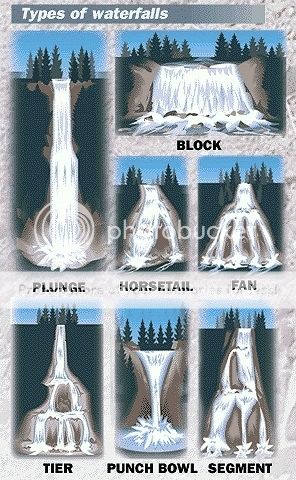Dunning's Spring, a city park in Decorah, is the site of the first mill built in the county seat. A boulder near the stream marks the spot where William Painter built a gristmill in 1849. By 1861, E.C. Dunning owned the property and replaced the original mill. Usage changed through the years. The structure was torn down in 1897. The park is enjoyed by visitors for picnics, hiking, weddings, and beautiful scenery.
Viewing the listed waypoint is accessible via the tiered walkway to the final platform.
Dunning Spring water originates near the base of the Galena Aquifer. The much less permeable Decorah Shale - the confining bed “floor” for the aquifer - is near the land surface, forcing the water to discharge from the wall of the Upper Iowa River Valley. The result is the picturesque falls. The groundwater issuing from the spring is flowing through an open, cavernous conduit, formed by the solutional enlargement of fractures. Solutionally modified fractures and cracks are the most common characteristic of karst.
The water from this (and most larger springs in the area) maintains a fairly constant temperature of about 45 degrees F most of the year. Exceptions occur after snowmelt or heavy rains when colder or warmer water rapidly enters the aquifer via sinkholes and losing streams.
Waterfalls are classified based on how the water falls or passes through it's course, how much water is flowing, the surface beneath it and the geological processes that created it (geomorphology). These all together form a waterfall's unique shape, it's fingerprint so to speak.

Waterfall Classification:
Block / Sheet: Water from a wide river or stream drops over a ledge forming what appears to be a "sheet" of water. A waterfall in a Block form occurs over a wide breadth of the stream. The waterfall must be wider than it is tall. A waterfall with this form does not have to be a solid sheet of water across it's entire width.
Cascade: A waterfall of a Cascade form descends over, gradually sloping rocks, a series of small steps in quick succession, or a rugged sloping surface of some kind. Cascades can be both gradual and steep. Cascade is a commonly used term when referring to waterfalls and rightly so. The term "cascade" comes from the Italian word "cascada" which actually means "waterfall". A cascade type waterfall is defined by the surface beneath it. It is one of the most common as the surface beneath it is irregular and encompasses the falls not classified elsewhere. It is generally water that flows down in small steps or stages. Multi-Cascading is more than one cascade in a row.
Chute: A violent section of water that is forced through a narrow passage due to cliff walls or large rocks. Depending on the descent angle, they may be classified as rapids not a waterfall. Very common in canyons where the water is wall-to-wall.
Classical: Similar to Block, water drops over a ledge but is close to equal in width and height.
Dry / Historic: This type of falls no longer exists with water flowing over it. It is referenced here, as some of these historical falls were very magnificent in their time. Dry Falls in Washington is one of these type and in it's day it was over 3 miles wide and had a huge flow of water, the unique thing about this falls was that it only flowed when the glacier lifted up to release the water.
Fan: Waterfalls of a Fan form occur when the breadth of the water in the waterfall increases during it's decent, causing the base of the falls to appear much wider than the top of the falls. Water falls through a relatively narrow crest and spreads out and becomes wider as it descends.
Frozen: These falls can be of any other type and it must have ice as a part of the falls. They are spectacular as the ice formations are just as unique as the falls themselves. If the temperature is just right, punchbowl falls will often form a cone in the bowl of water.
Horsetail: Water descends down remaining in contact with the surface most of the time. Horsetail waterfalls are characterized by the constant or semi-constant contact the water maintains with the bedrock as it falls. Horsetail waterfalls can be almost vertical, as well as very gradual.
Keyhole/Slot: Water pushes through a narrow area before falling. A keyhole is a special slot as it has a rounded part at the bottom of the slot resembling the old fashioned keyholes. Some times the water has forced (eroded) out a part of the rock causing an actual hole water falls from.
Plunge: The classic and overly cliched waterfall form, where the water drops vertically, losing most, or all contact with the rock face. This waterfall form has also been referred to as a "Cataract" and a "Vertical" form waterfall.
Punchbowl: Punchbowl waterfalls, coined from the famous Punch Bowl Falls in Oregon, occur where the stream is constricted to a narrow breadth and is forcefully shot outward and downward into a large pool.
Segmented: Pieces of land segment the river (same watercourse) causing the water to fall in sections. Not to be mistaken with different watercourses forming different waterfalls side-by-side as in Parallel / Twin falls.
The Logging Requirements:
1) How high or tall do you estimate the waterfall to be?
2) How wide do you estimate the waterfall to be?
3) Using the waterfall classification guide above, what classification of waterfall do you believe the waterfall is?
4)Explain why you chose this classification?
5) Dunning’s Spring flows into what nearby river?
If you have a physical disability, which prohibits you from accessing this earthcache from the trail, credit will be accepted per abilities to obtain information.
Email your answers via my profile; please include the earthcache name Dunning’s Spring, number in your party, and cachers’ names. One email per caching group.